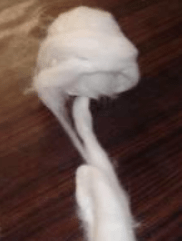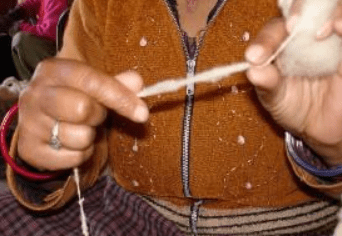History of Hand Spinning
Spinning is the technique of twisting fibers to make yarn that can be used to produce textiles. It is one of the oldest crafts, dating back several thousand years, and has been practiced in all cultures of the world in some form or the other. The process of spinning evolved from the twisting of the fibers by hand.
This was gradually replaced by the drop spindle and then the spinning wheel. The spinning wheel or charkha became a symbol of India’s Independence movement under the leadership of Mahatma Gandhi. He stressed the importance of hand spinning and the handloom industry for India’s economic progress.
Hand Spinning
The crafts of hand processing of fiber and handloom weaving in India have been par excellence and were the mainstay of India’s economic strength before colonialism. With the Industrial Revolution in Europe raw cotton began to be exported to British mills for producing textiles that traveled back to India for sale as they were cheaper than handloom textiles.
Khadi, the hand-spun and handwoven fabric mostly woven in cotton, became the tool to fight the onslaught of cheaper imports from England. Despite stiff competition from machine-made fabric, hand spinning and handloom weaving are still practiced in several parts of the country, and employ millions of people.
Cotton, silk, wool, alpaca, angora, mohair are some of the fibers that are used for hand spinning. The mountainous areas have traditionally been engaged in hand spinning and weaving as weather conditions necessitated engagement with these crafts.
Regions of Production (hand spinning)
The higher mountain areas of Himachal Pradesh, Jammu & Kashmir and Uttaranchal have a tradition of hand spinning.
Producer Communities of hand spinning
Hand spinning is generally done by women across communities.
Raw Materials of hand spinning
The raw materials used are fibers such as wool and silk. Wool fibers used for spinning are local wool, local merino, Australian merino, angora wool. Among silk fibers, tussar and eri silk are used. Silk is generally used in making blended yarn such as pure angora with pure silk.
hand spinning Tools
Tools used for hand spinning of various kinds of fibers are: drop spindle and charkha depending on the spinning method being used. The drop spindle is lightweight and inexpensive. It consists of the following parts: whorl (weight), shaft, spindle (stick), and hook.
The charkha is a large wheel that is rotated by hand. Its rotation in turn rotates the spindle that spins the fiber. Blending of yarns is done through Bradford spinning wheel or similar local spinning wheel.
hand spinning process
The wool procured from the market is un-scoured (in its natural state). Before the wool can be spun it has to be cleaned. Cleaning the wool by hand involves 2 processes:
•Hand picking: This is done by teasing small amount of wool by fingers so that dirt can fall out.
•Hand carding: Carding opens the fibers and makes them lie parallel and uniform for the purpose of spinning. It can be done either by hand carders flat wooden paddles with closely set rows of short metal teeth. Hand carding is a time consuming process. Carding can also be done on machines.
Spinning forms
•Fine spinning: the spun yarn is of a fine texture. In this case, the spinner holds the fiber longer in her hand before releasing it for spinning. This leads to a higher twist.
•Thick spinning: The fiber is held loose and therefore allows for a lower twist. Fine and thick spinning also depend on the fibers used.
Creating blends: Yarns of the same kind or of different varieties are combined (such as pure angora and pure silk or angora with Australian merino).
hand spinning Techniques
•Drop Spindle
This is perhaps the oldest technique of spinning yarn. The spinner can spin with it wherever he/she is, whether at home or while grazing cattle.
Process of spinning on a bottom whorl spindle
-A piece of yarn about 18 inches long called leader, is first tied on the shaft above the whorl. It is then carried over the side of the whorl, around the shaft from underneath, over the side of the whorl again, and finally attached to the hook on top of the spindle or the stick.
The spindle now lies suspended by the leader. More wool is attached to the free end of the leader by spinning the spindle clockwise. Once the yarn is long enough to touch the ground it is unhooked.
The spinner now drafts the fiber –pulling strands of fiber from the sliver to be twisted by the spinning movement of the spindle. The spun yarn keeps getting wound at the bottom. When the spindle movement becomes wobbly it is time to take the spun yarn out of the spindle to be rolled into a bundle.
To spin a fine yarn the spinner holds the fibers tightly allowing for greater twist. In case of thick yarn the fibers being released from the sliver are held loose. In this area generally older women spin on the drop spindle as they are adept in its usage and averse to changing to other efficient forms.
•Hand Operated Spinning Wheel or Charkha
The spinner sits on the ground. The charkha comprises of a drive wheel that is rotated by hand. Its rotation in turn rotates the spindle that spins the fiber.
•Spinning Wheel for Blends of Yarn
Bradford from New Zealand and other similar local spinning wheels such as Medlerry from Karnataka are being used to design pre-spun yarns into a variety of blends. Yarns of the same kind or of different varieties such as pure angora with a wool core are blended or spun together to create unique yarns.
Some of the main components in these spinning wheels are: wheel or charkha that rotates other parts; treadle or pedals for rotating the wheel; bobbin for storing the yarn; flyer; flyer whorl; drive band (chord that goes around the wheel and the flyer whorl);and the opening through which the yarns to be spun pass through.
The treadle/pedal movement rotates the wheel that in turn rotates the flyer. The spinner’s hands are free to hold or release the yarn. The flyer movement twists the fiber that keeps winding on the bobbin.
hand spinning Product Range
The hand-spun yarn produced is dyed and woven to create a range of woven, knitted, and crochet products. The product range includes yardage, stoles, shawls, mufflers, etc.
Changes
Technology
Spinning of all kinds of fibers is being carried out by traditional hand spinning techniques of drop spindle and hand-driven wheel or charkha. With the introduction of spinning wheels like Bradford and similar local innovations, it has become possible to create blends of different varieties of yarn in varying textures.
Market
Presently handloom weavers everywhere mostly use mill-spun yarn. However, the dexterity of the hands creating varying textures and shapes in case of hand spinning is beyond comparison and emulation.
It is this uniqueness that is the strength of hand spinning and underlies its potential to play a significant role in the economic growth of the country. The hand woven products made out of hand spun wool are sold locally in Himachal Pradesh as the state attracts a lot of tourists.
Besides the local markets they are also sold nationally and in international markets.
Design
Hand-spun yarn has a particular character and unevenness that cannot be emulated by mills. It is this that makes it distinctive. The recent creation of blends of pre-spun yarns of the same kind or of different kinds in a variety of textures and colors is a fine example of design leading to value addition.




